
Bio-ship Paladin, known in Japan as Space Battleship Gomora, is a 1990 horizontally scrolling shoot 'em up arcade game released by UPL and distributed by Sammy Corporation for North American manufacture. It was later ported to the Sega Mega Drive. While the game is essentially a standard horizontally scrolling shoot 'em up, it has an innovation that makes it unique in the genre. The player flies a spaceship which has the standard forward guns to be found in all horizontal scrollers, but it also possesses a weapon that can be manually targeted with a crosshair, in the same manner as in the game Missile Command. This allows the player to fire in any direction with pinpoint accuracy, and adds an extra level of strategy to the game. The game saw an almost arcade perfect port on the Mega Drive, albeit with a few changes that actually enhanced the look of the game such as added parallax scrolling backgrounds in the second level. It would eventually see a worldwide re-release as part of the Arcade Archives series for Nintendo Switch and PlayStation 4 on August 5, 2021.
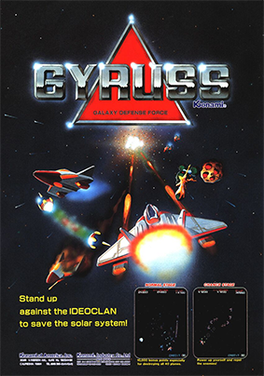
Gyruss is shoot 'em up arcade video game designed by Yoshiki Okamoto and released by Konami in 1983. Gyruss was initially licensed to Centuri in the United States for dedicated machines, before Konami released their own self-distributed conversion kits for the game. Parker Brothers released contemporary ports for home systems. An enhanced version for the Family Computer Disk System was released in 1988, which was released to the North American Nintendo Entertainment System in early 1989.

Vega Strike is a first-person space trading and combat simulator, developed for Microsoft Windows, Linux, FreeBSD and OS X systems. Many of the core game mechanics of Vega Strike are indirectly inspired by Elite. Other games, such as Wing Commander: Privateer, influenced the original developer.

Abadox: The Deadly Inner War is a video game for the Nintendo Entertainment System published in Japan in 1989 by Natsume and North America in 1990 by the Milton Bradley Company. It is a horizontally scrolling shooter in the vein of Gradius and R-Type taking place inside the intestinal tract of a giant alien organism. Abadox has a high difficulty, and it takes one hit from an enemy projectile to be killed and restart from a checkpoint passed before death.

To the Earth is a light gun shooter video game developed by Cirque Verte and published by Nintendo for the Nintendo Entertainment System. It was released in November 1989 in North America and in Europe on February 23, 1990. It uses the NES Zapper to destroy ships and gain power-ups. The enemy spacecraft require good reflexes and aiming.
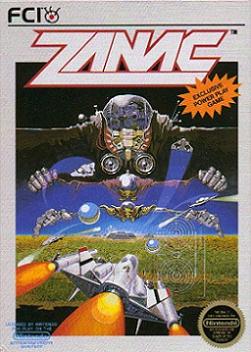
Zanac (ザナック) is a shoot 'em up video game developed by Compile and published in Japan by Pony Canyon and in North America by FCI. It was released for the MSX computer, the Family Computer Disk System, the Nintendo Entertainment System, and for the Virtual Console. It was reworked for the MSX2 computer as Zanac EX and for the PlayStation as Zanac X Zanac. Players fly a lone starfighter, dubbed the AFX-6502 Zanac, through twelve levels; their goal is to destroy the System—a part-organic, part-mechanical entity bent on destroying mankind.

Silpheed is a video game developed by Game Arts and designed by Takeshi Miyaji. It made its debut on the Japanese PC-8801 in 1986, and was ported to the Fujitsu FM-7 and DOS formats soon after. It was later remade for the Sega CD and has a sequel called Silpheed: The Lost Planet for the PlayStation 2.
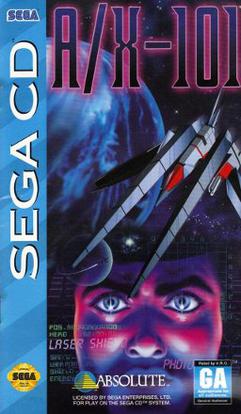
A/X-101 (エーエックス101) is a 1994 rail shooter/FMV video game for the Sega Mega-CD.
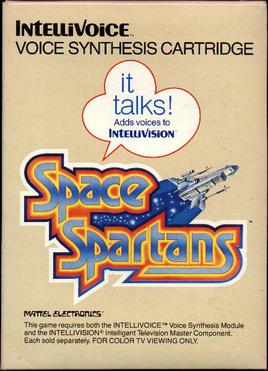
Space Spartans is a space combat simulator video game released for Intellivision, initially programmed by Brian Dougherty, and completed by William C. Fisher and Steve Roney. It is the first game which supported the Intellivoice voice synthesis module. Space Spartans is heavily based on Star Raiders, a game released in 1980 for the Atari 8-bit computers.

Earth Defense Force is a 1991 horizontal scrolling shooter video game developed and published by Jaleco. Originally an arcade game, the game was later released for the Super Nintendo Entertainment System as Super Earth Defense Force, dropping the two-player cooperative gaming mode while adding graphics and selectable weapons. The SNES version was released in Japan on October 25, 1991, and in North America in January 1992. The SNES version was eventually released on the Wii Virtual Console in Europe on October 29, 2010, and in 2011 for Japan on January 11, and North America on July 14. It is included in Nintendo Switch SNES Online as of September 2019.
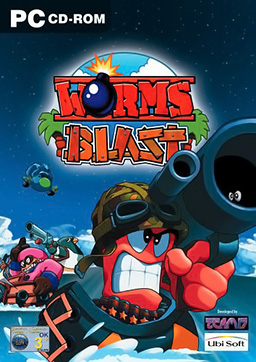
Worms Blast is a puzzle video game for Microsoft Windows, PlayStation 2, GameCube, Game Boy Advance and Mac OS X released in 2002, developed by Team17, and published by Ubi Soft. The Mac version was developed and published by Feral Interactive.

Vertical Force is a 1995 vertically scrolling shooter video game developed and published for the Virtual Boy by Hudson Soft in Japan and by Nintendo in North America. The player controls a starship, the Ragnarok, that must destroy a malfunctioning supercomputer on a human colony planet before it wipes out all of mankind. Gameplay is similar to Hudson's Star Soldier series, featuring power-up items that increase the player's abilities and parallax scrolling. The player can move their ship farther into the background to avoid enemies and obstacles in the way.
Blaster is a first-person rail shooter released as an arcade video game by Williams Electronics in 1983. It was developed by Eugene Jarvis and Larry DeMar. A vague sequel to Robotron: 2084, the game is a shoot 'em up set in outer space. The goal is to destroy enemies, avoid obstacles, and rescue astronauts in twenty levels, to reach paradise.

Star Voyager is an outer space shooter for the Nintendo Entertainment System. The gameplay is a first-person shooter from inside the cockpit of a spaceship. The player navigates "sub spaces" of a larger "world map." Gameplay takes place between different subspaces.

Robotica, also known as Robotica Cybernation Revolt in Europe and Deadalus (ダイダロス) in Japan, is a first-person shooter which was released for the Sega Saturn in 1995.

Super Glove Ball is a game made by Rare in 1990 for the Nintendo Entertainment System, specifically designed to be played with the Power Glove controller. However, it can also be played with a standard NES controller. It was sold separately from the Power Glove.

Xexex, released as Orius in North America, is a 1991 side-scrolling shoot 'em up arcade game by Konami. It draws on Irem's R-Type and Konami's other shoot 'em up Gradius, while adding the tentacle mechanics of Irem's other shoot 'em up XMultiply. In the game, players take control of the Flintlock space fighter in a mission to rescue Princess Irene La Tias of Planet E-Square, who has been captured by the evil galactic warlord Klaus Pachelbel.
Sinistron, released as Violent Soldier in Japan, is a horizontally scrolling shooter released for the TurboGrafx-16 in 1990.

Section Z is a horizontally scrolling shooter by Capcom, released as an arcade video game in 1985. A home version was published for the Nintendo Entertainment System in 1987.

Total Eclipse is a space flight simulation video game developed and published by Crystal Dynamics for 3DO. It was later ported to the PlayStation under the title Total Eclipse Turbo. The game was copyrighted in 1993 and released 1994. Total Eclipse Turbo was a launch title for the PlayStation in the U.S., with the game's released date predating the North American console launch by 11 days. A sequel, Solar Eclipse, was released for Sega Saturn and PlayStation.















